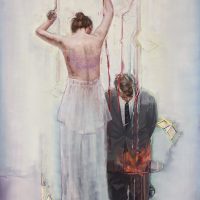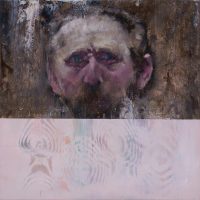Ceremony, 2015, oil on gesso on board, 200 x 140 cm, Private Collection, Italy
Csontváry, 2015, oil on gesso on board, 33 x 33 cm, Private Collection, Budapest
The “ghosts” of the past, that is, the phantoms of history and the reminiscences of art history have always played a determining role in Szűcs’s art. The post-conceptual and post-medial painting of his is still haunted by one of the basic problems of Conceptual Art and Modernism: the inextricable interconnectedness of tangible reality and its various representations.
Szűcs’s body of work evokes the philosophical questions of Conceptual Art pertaining to the role of art in society, and it comments on the visual culture of Modernist painting (Abstract Expressionism, geometric abstraction) dedicated to aesthetic autonomy. With each of his works, Szűcs attempts to give aesthetically and politically thought-provoking answers to diverse groups of intellectual and material problems, which guide the eye from cultural remembrance, personal memories, as well as the media-influenced visual documents thereof all the way to the material aspects of colors and lights.
In a number of his works Szűcs features well-known historical figures like Nikola Tesla, Miklós Horthy, Buster Keaton, Adolf Hitler, and János Kádár, at the same time seeking to reinterpret these personalities with the tools of painting. The famous and lesser-known people in his pictures are usually hard to grasp and mysterious, that is, ghostly, even in the Freudian sense (unheimlich) because most of them are captured in unbounded and desolate spaces, loitering in an unusual way.
Szűcs enhances the ambivalence in the characteristic blurriness of the figures and the space with “tricks” relating to both technique and composition, which are based on the physiognomy of human vision (blind spot, stereopsis). Manifested in experiments of form, his themes often bring to mind powerful historical allusions, which in turn can also invoke the specters of Marx and Derrida, and the phantom-like, volatile notions and figures of communism and capitalism, all of which continue to have a considerable influence on the cultural life of post-Socialist Hungary and the whole of Europe, as well as their relation to the past.
Attila Szűcs is one of the most outstanding mid-generation painters of East-central Europe; his carrier started at the time of the collapse of the Socialist regimes, while in the 1990s he played a significant role in Hungary in the creation of a painting that is conscious of the medium, as well as politically and culturally reflected. From the 2000s onward, a parallel can be drawn between the painting of Szűcs and of regional movements like the Neue Leipziger Schule and the Cluj School of Painting, while his unique relation to cultural tradition and to painterly technique ensures him a distinct place within these tendencies.

